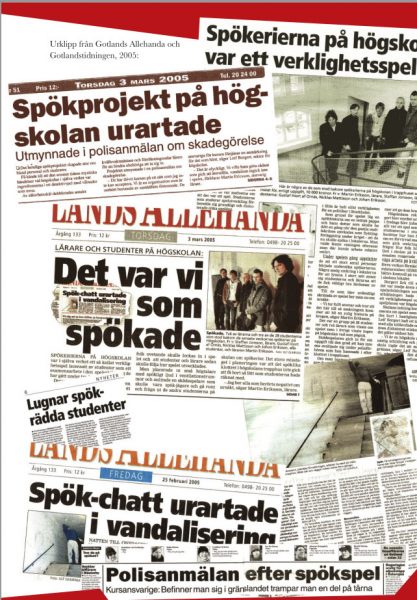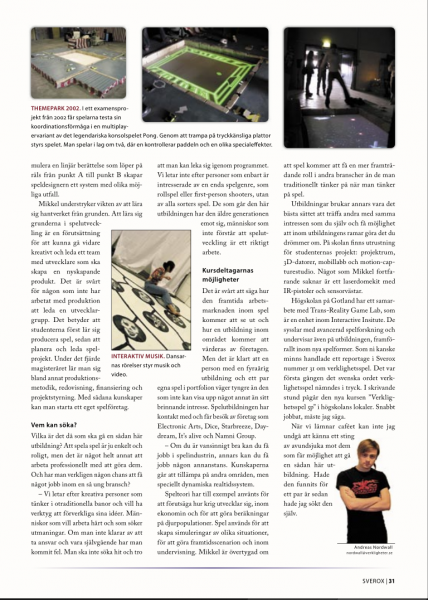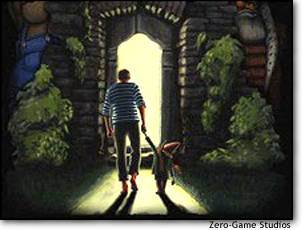Verklighetsspel was a short (and short-lived) course in which students created what, today, we would call an Alternate-Reality Game. In early 2005 the first class of students secretly launched their game on campus – a virtual haunting. Unfortunately the course responsible had neglected to notify the rest of the university about the game happening! It it went so far that staff and students were quoted in media as being too afraid to be on campus. The janitors would refuse the night shifts, police had to investigate messages from the dead and the GAME students even hired an actor to play a professional medium. The poor actor was brought in by police for questioning, without ever breaking character! 😀

Unfortunately almost all information about the event is in Swedish, but for those who can, check out this article / write-up by Gabriel Widing (who was also involved in Zero Game Studio back then!):
Swedish Radio reported Verklighetsspel skrämde studenter, and Hela Gotland wrote about the aftermath. You should be able to bypass the paywall by browsing in Incognito Mode. Here are some excerpts from the piece:
Spökerierna på högskolan var ett verklighetsspel
Publicerad 2005-03-03
Spökerierna på högskolan har fått mycket uppmärksamhet under den senaste tiden. Nu avslöjas att spökerierna i själva verket ingick i en fempoängskurs. […] När personalen på högskolan började bli rädda för att gå till jobbet avbröts spelet.
[…] Folk skulle lockas in utan att de var medvetna om att det var ett spel. Studenterna som studerar spelutveckling förberedde sig grundligt och diskuterade olika upplägg. Man placerade medvetet ut olika “kaninhål” där nya deltagare skulle lockas in i spelet. Man placerade konstiga anteckningar i böcker framlagda på strategiska ställen på biblioteket. Också en skådespelare anlitades. Denne skulle gå omkring i högskolans lokaler och föreställa en spökjägare. De studenter som träffade på mannen trodde fullt och fast att det här var en person som var fullständigt övertygad om att det fanns spöken i lokalerna. Man placerade ut små högtalare i skolans ventilationstrummor så att den spökliga barngråten och sången skulle höras men vara svår att lokalisera. Man satte även ihop en stack av stolar så att det skulle se ut som ett poltergeistfenomen, och man gjorde en websida där de som höll i spelet skulle ha en koll på hur det utvecklade sig.
[…] Studenterna som går den här kursen ska lära sig allt om moderna spel och den här typen av verklighetsspel är något som kommer starkt, spökerispelet var deras examensuppgift “Den hemsökta högskolan”. […] Som grund för spelet låg en spökhistoria om en lettisk pappa och hans dotter som skulle ha dött en gång när den gamla maltfabriken användes som flyktingförläggning under kriget – att de nu skulle spöka i lokalerna. […]
[…] Det var en grupp på 28 studenter och två lärare som visste om spelet men i övrigt visste ingen på högskolan vad som pågick. Skådespelaren gick in för sin uppgift till den grad att han inte ens avslöjade sig under polisförhören som han hamnade i efter klottret i trapphuset.
Högskolans rektor Leif Borgert […] berättar hur han fick rapporter om en förvirrad man i kafeterian som gick omkring och ställde frågor. Hur folk hörde konstiga ljud i skolan på kvällarna. Personalen reagerade med att inte våga arbeta på kvällarna. Under förra veckan förstärkte han vaktmästarstaben tillfälligt för att ha bättre kontroll på vad som hände i skolans lokaler.
Borgert fick till slut veta att det var tredje årets studenter på spelutbildningen som i ett led i utbildningen hade konstruerat ett verklighetsspel och att själva spelplanen var högskolan.
[…]
– Vi är en högskola med konstnärlig utbildning och på en högskola ingår det att man provar gränser, säger Leif Borgert som nu, när han har fått distans till det, ser lite annorlunda på det hela.
TEXT: Ulf Glimfalk
This post has been back-dated. It was published on 2018-02-18.





